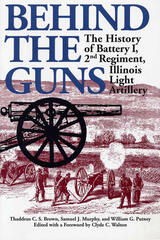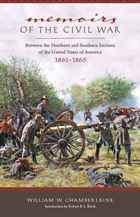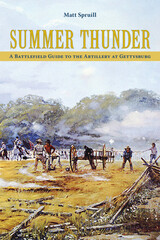
Much has been written of the infantry and the cavalry during the Civil War, but little attention has been paid the artillery. Through the battles of Chickamauga and Missionary Ridge in 1863 and the Atlanta Campaign of 1864 and with General Sherman’s forces on the famous March to the Sea, the acts of a courageous fighting group are vividly recounted in Behind the Guns: The History of Battery I, 2nd Regiment, Illinois Light Artillery. Originally published in 1965 in a limited edition, this regimental history of a light artillery unit was written by three of its soldiers, including the bugler.
Battery I was formed in 1861 by Charles W. Keith of Joliet and Henry B. Plant of Peoria. More than a hundred men were mustered into service in December near Springfield and left for Cairo in February 1862. The battery trained at Camp Paine across the Ohio River in Kentucky until March, when the men were dispatched to the South. During the war, the Battery was attached to three different armies: the Army of the Mississippi, the Army of the Ohio, and the Army of the Cumberland.
Clyde C. Walton’s foreword and the narrative discuss the variety of weapons used by the unit, including James, Parrott, and Rodman guns and the bronze, muzzle-loading Napoleons that fired twelve-pound projectiles. The book also includes an account of the prisoner-of-war experience of Battery I lieutenant Charles McDonald, biographical sketches of the battery soldiers, and eighteen maps and five line drawings.

Memoirs of the Civil War, though relatively little known because of its rarity in the original edition, contains much valuable information and engaging narrative passages. A Virginian whose Confederate career included service in an infantry regiment early in the war, Chamberlaine’s most important military service was as a staff officer attached to Brigadier General Reuben Lindsay Walker, who commanded the Third Corps artillery in the Army of Northern Virginia.
Includes excellent material on the duties of staff officers, operation of Confederate conscription, and the role of artillery in Lee’s campaigns. He is especially eloquent and revealing about a number of famous battles: the Seven Days; Antietam, where Chamberlaine distinguished himself and was wounded; and the Wilderness, where he had a memorable encounter with Lee.


Among the myriad books examining the Battle of Gettysburg (July 1–3, 1863), Summer Thunder is one of a kind. A terrific resource for is visitors to the national military park, it explores the clashing armies’ deployment of artillery throughout the battle—from one position to another, from one day to the next. Matt Spruill, a retired U.S. Army colonel and former licensed Gettysburg guide, carefully takes readers to every point on the battlefield where artillery was used, and combining his own commentary with excerpts from the Official Records and other primary sources, he reveals the tactical thinking of both Union and Confederate commanders.
Spruill uses a sequential series of thirty-five “stops,” complete with driving instructions and recent photographs, to guide readers around the park and orient them about where the opposing units were placed and what happened there. Detailed maps depict the battlefield as it was in 1863 and are marked with artillery positions, including the number of guns in action with each battery. Meanwhile, the passages from primary sources allow the reader to see key events as the actual participants saw them. The book also brims with information
about the various artillery pieces used by both sides, from howitzers to Parrott rifles and Napoleon field guns, and the critical role they played over the course of the battle, right up its outcome.
Summer Thunder devotes a chapter to each of the three days of the historic devotes a chapter to each of the three days of the historic Summer Thunder engagement between the Army of the Potomac and the Army of Northern Virginia. One can follow the battle chronologically in its entirety from Stop 1 to Stop 35, or concentrate on a specific day or a specific area. In fact, the maps and orientation
information are of such detail that the book can be used even without being on the battlefield, making it an invaluable reference work for expert and novice alike.
READERS
Browse our collection.
PUBLISHERS
See BiblioVault's publisher services.
STUDENT SERVICES
Files for college accessibility offices.
UChicago Accessibility Resources
home | accessibility | search | about | contact us
BiblioVault ® 2001 - 2024
The University of Chicago Press









